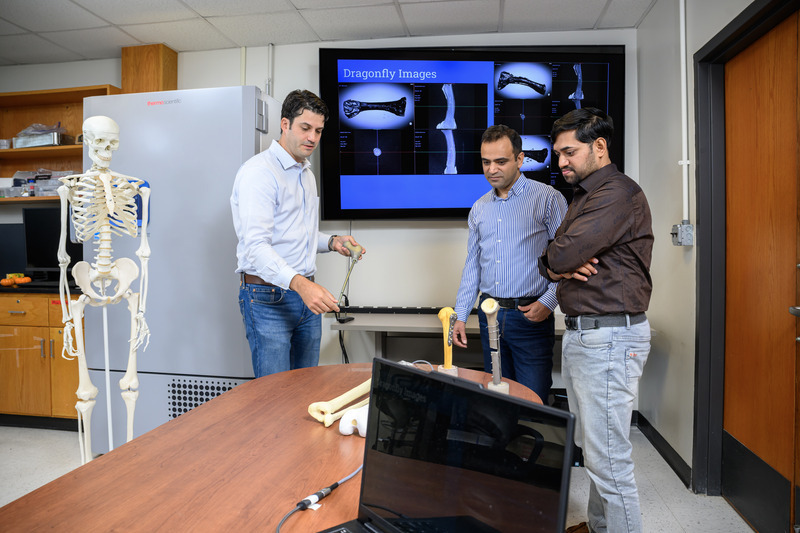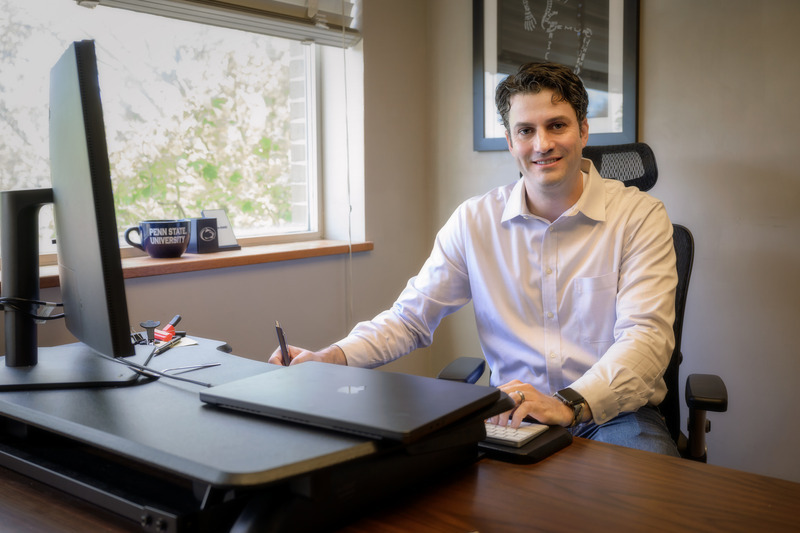


Engineering a clearer view of bone healing
Photos by Kathy F. Atkinson October 31, 2025
UD engineer Michael Hast leads an NIH-funded effort to identify impaired bone healing earlier with MRI-based computer models
Healing a broken bone can take months, and knowing whether recovery is on track often takes just as long. Doctors typically rely on periodic X-rays, capturing two-dimensional images to see how the bone is growing back together. Patients return for follow-up scans every few weeks or months, repeating the cycle until the bone shows signs of complete healing.
Healing of shin bone (tibia) fractures, in particular, slows or stalls up to 25% of the time. Factors such as age or underlying health conditions like diabetes can influence the speed of fracture healing. Delayed or incomplete healing can lead to long-term pain and ongoing medical care.
A new five-year, approximately $3 million project led by University of Delaware mechanical engineer Michael Hast seeks to develop radiation-free imaging techniques that identify problems with bone healing sooner. Supported by an R01 grant from the National Institutes of Health, the work strives to help health care providers take a more proactive approach to addressing problems with bone healing. If successful, this approach could enable faster, more personalized patient care.
Hast’s lab develops and uses 3D computational models to estimate the strength of a healing bone. Such models allow the team to simulate real-world stresses, such as twisting, to evaluate how sturdy a fracture is as it mends. Traditionally, these personalized models have been built from computed tomography (CT) scans. The drawback is that each CT scan exposes patients to ionizing radiation, which can be harmful with frequent exposure.
Recent advances in magnetic resonance imaging (MRI) are giving researchers a new way to look at bones without exposing patients to radiation. While standard MRI technology provides detailed views of soft tissues, it struggles with hard, dense bone. A new approach called ultrashort echo time MRI now makes it possible to quickly capture detailed images of healing bone fractures.
“The ability to perform radiation-free imaging of the healing bone is a game-changer,” said Hast. “With enough data, we should be able to identify problems with fracture healing much earlier. This could guide treatment decisions, such as adjusting physical therapy routines or activity levels.”

Translating MRI data into useful computational models is no small task. Hast is collaborating with modeling expert Hannah Dailey at Lehigh University, and with surgeons at the University of Pennsylvania, on the project.
By mapping MRI data to the mechanical strength of each tiny 3D element, or voxel, they seek to generate a model that behaves like real bone when subjected to simulated movement or stress.
Working first with a sheep model of bone healing, the researchers will test whether the MRI-based models accurately reflect the mechanical strength of a healing bone compared with laboratory measurements.
They also plan to evaluate how well the MRI approach predicts healing in people undergoing tibial fracture repair surgery. Over the next five years, the team plans to enroll approximately 50 participants at the University of Pennsylvania, following each participant for a year to track long-term recovery.
In the future, the team hopes their findings will help clinicians rapidly assess how well new bone is developing and whether it is strong enough to withstand stresses from activities of daily living. Hast noted that newer evidence suggests that getting up and moving as soon as possible benefits healing of leg fractures.
“A better predictive tool could give clinicians and patients more confidence that a healing bone can handle the stress of physical activity without risking a repeat fracture," he said. “Our hope is to identify early warning signs of poor healing so providers can adjust rehab protocols sooner and get patients back on track faster.”
Funding is provided by NIH’s National Institute of Arthritis and Musculoskeletal and Skin Diseases under award number AR083052.
Contact Us
Have a UDaily story idea?
Contact us at ocm@udel.edu
Members of the press
Contact us at mediarelations@udel.edu or visit the Media Relations website

